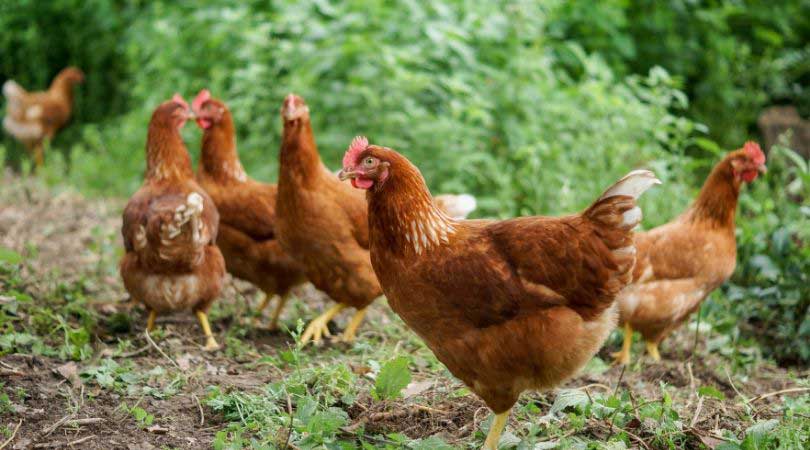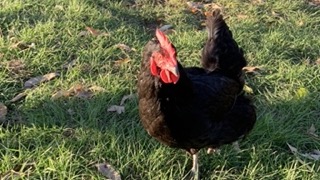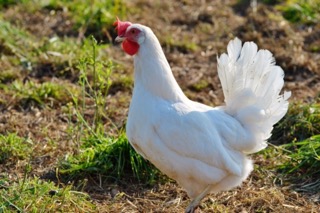What are the Best Egg Laying Chickens?
The primary reason for most people to raise backyard chickens is to receive fresh, delicious farm eggs. If you've never had a fresh egg, you don't know what you're missing. In fact, you haven't really had an egg until you taste one delivered by a backyard chicken. So the question for many people is, What are the Best Egg Laying Chickens?
Not all chickens are alike. Some chickens lay hundreds of eggs a year. Others produce very few. If you plan to invest in a few chickens rather than buying eggs from the store, there are important things you need to know. Which breeds are the best chickens for laying eggs, and also which ones produce few, if any, eggs. Before becoming a full-fledged chicken farmer, take a minute to learn the basics about laying hens.
When will hens start to lay eggs?
Most breeds begin laying eggs between five and six months old. You should expect the first few eggs from a new laying hen to be a little unusual. They may be small as well as strange in shape. Some may also have a double yolk. All of these are just fine to eat. It can take a little time for a young hen's body to adjust to that of a mature egg layer. It won't be long before they get the routine down.
How many eggs can you expect?
This depends on a large number of factors. Good egg laying chickens will produce an average of one egg every 24 to 48 hours. Of course, this requires a balanced diet as well as enough daylight.
The breed of chicken has a much larger impact on the amount of eggs you receive than you may anticipate. If you walk in to this blindly, you may just end up with egg on your face instead of on your plate. Some breeds, like Japanese Bantams, may lay less than an egg a week.
On the other hand, many hybrid breeds lay an egg almost every day. This amounts to nearly 300 or more eggs a year just from one chicken! If you have just four Isa Brown hybrid hens, you can yield close to a 1000 or more eggs in a year! That's a lot of omelettes!
The best egg laying breeds
As a rule, commercial laying breeds, usually known as hybrids or sex-link chickens, tend to be the best egg laying breeds. These include ISA Browns, Comets and commercial Leghorns, but there are many other trademarked breeds available too. These chickens will lay over 300 eggs per year.
Of the heritage chicken breeds, some are excellent layers. Australorps, Leghorns, Plymouth Rocks and others will also produce 300 eggs or more per year. Others heritage layers produce only 200-250 eggs, like Welsummers and Rhode Island Reds.
But when comparing chicken breeds for the best egg layers, it is important to remember that while commercial breeds lay very intensively, they tend to stop laying quite early, often at 3 years of age. Heritage breeds, on the other hand, lay less intensively but usually have a longer life expectancy and lay eggs for longer, although production does decrease with age.
Here's a look at some of the Best Egg Laying Chickens:
ISA Brown Chickens

Hybrid chickens often tend to be the greatest egg-producers. ISA Browns are a hybrid breed that really is in a league of their own. They are certainly up their with the Best Egg Laying Chickens.
These hens can be expected to lay up to 300-350 eggs per year. That's almost one each day of the year!
Many ISA Browns even start laying earlier than most other breeds. A good Isa Brown hen may start laying as soon as 16 weeks. That's a full month to two months earlier than most breeds.
Not only are these hybrid hens incredible egg layers, they are also easy-going. As well as that they are a low maintenance chicken which easily adapts to most climates. What ISA Browns do need is a good diet - a top quality, high protein layer feed and minimal treats. With an inadequate diet, ISA Browns are far less productive and can resort to feather-pecking.
ISA Brown hens weigh approximately 2kg. That is quite robust for a chicken. Likely it is their hefty size that accounts for their large egg production. There is little doubt that a few ISA Brown chickens will keep you well supplied in fresh eggs all year long.
Rhode Island Red Hen
If you are in search of the Best Egg Laying Chickens for your backyard, some breeds will practically take care of themselves. And while they take care of themselves, they also provide an abundance of eggs. Rhode Island Reds may be exactly what need. These chickens are friendly as well as tough.
A Rhode Island Red hen will also provide you with about 250-300 eggs a year. On average, these hens lay four to five brown, medium to large eggs per week. Rhode Island Reds are also long-lived, with a life expectancy of 5-8 years.
Contrary to what their name may lead you to believe, these chickens have dark brown and black feathers. This gives them a darker, almost deep reddish brown appearance for which they are highly valued. They are well-known to be hardy, tough chickens that can withstand the elements. Rhode Island Reds are often the choice of many first-time chicken buyers since they are easy to raise and produce a large amount of eggs.
These backyard chickens are famously easy-going and tough, making them an ideal pick for anyone in search of a no-fuss breed of laying hens. However, if you plan to keep a rooster, Rhode Island Reds may not be the best choice for a backyard flock as the roosters can be quite aggressive.
Australorp Hens

Australorps are an Australian-bred chicken adapted from the British Black Orpington.
On average, these practical and productive chickens lay 250-300 eggs per year. Their eggs are of a light brown colour and medium in size.
Australorps are a free-range chicken that like to have plenty of room to roam. They are beautifully docile and laid-back creatures that adapt easily to their surroundings. Highly prized for their beautiful appearance, these chickens will provide you with an abundance of eggs throughout the year provided they are given enough room to range.
Leghorn Hens

Leghorn chickens have remained a popular backyard chicken since the 1800s.
These beautifully unique chickens lay 280 or more eggs per year. On average, a Leghorn hen will lay four beautifully pristine white, medium to large eggs a week.
While many associate Leghorns with the traditional white plumage and a large red comb, many varieties of Leghorns are available with an assortment of colourful plumage. These exquisite laying hens make for great backyard chickens to keep you supplied in fresh eggs throughout the year. However, keep in mind they are extremely shy and skittish. If you are looking to make friends with your laying hens, you may be in for a challenge. On the other hand, if you are looking for egg layers that will simply keep you supplied with fresh eggs while keeping their distance, the Leghorn may be exactly what you are looking for.
Other Good Egg Layers
While this list of the top egg laying chickens by no means covers all the best egg laying hens, it is a start for those new to the world of backyard chickens.
Other good egg layers include Plymouth Rock, Ancona, Wyandotte, Maran, Barnevelder, Minorca, Orpington, Welsummer, New Hampshire and Hamburg. Each of these breeds will likely produce 200 or more eggs per hen, per year.
White, Brown, Green, or Blue?
While fresh eggs from backyard chickens are delicious no matter what colour they are, some people claim there is a taste difference depending on the colour of the egg. And even if they taste the same, everyone loves a carton of rainbow eggs!
Some chicken breeds, such as the Araucana and Cream Legbar, lay blue eggs. While Araucanas primarily only lay blue eggs, many times they appear more green in color depending upon how much sunlight they get, as well as their diet. You can expect these unique chickens to lay around 250 eggs a year.
Like the Araucana, the Cream Legbar also is known for its beautiful blue eggs. The Cream Legbar are a very active chicken breed and good foragers. This makes them popular as free range chickens that don't require much attention. This chicken is known to lay approximately 200 eggs per year.
Best Egg Laying Chickens for Brown Eggs
If it's brown eggs you're after, these chickens are some of the better known brown egg layers:
- Rhode Island Red
- Welsummer
- Delaware
- Buff Orpington
- Jersey Giant
- Plymouth Rock
- New Hampshire
- Wyandotte
Many sex-link and hybrid chickens also produce brown eggs.
Best Egg Laying Chickens for White Eggs
If nothing but white will do, these backyard hens are all known to produce white eggs:
- Leghorn
- Ancona
- Egyptian Fayoumis
- Andalusian
- White Siciliana
- Minorca
- Lakenvelder
- Hamburg
- Crevecours
In the USA, hybrid breeds that produce white eggs are also abundant. Ask your local hatchery for recommendations!
How to Keep Egg Production High
Once you select the type of hens that are right for your backyard chicken endeavours, you will need to educate yourself as to the best way to keep those hens laying. Just because you've purchased a breed that is known to be a prolific egg layer doesn't mean they will automatically lay eggs and keep laying them. A number of factors contribute to an egg layer's egg laying capabilities. Diet and access to daylight are the two most important factors that determine how many and how often your backyard hens will produce those delicious eggs. The age of your chickens also has a lot to do with it.
Age
Face it, we all slow down a little the older we get. This holds true for chickens as well. Have you heard the phrase, “She's no spring chicken anymore?” The sad truth is, once a hen reaches a certain age, her egg production decreases dramatically. The first 2 years of egg laying are generally the most productive for commercial and hybrid breeds. For heritage breeds, 3 and sometimes 4 years of productive laying can be expected. After this time period, you can expect a gradual decrease in the amount of eggs your ageing hens give you.
Diet
Chickens require at least 20 grams of protein on a daily basis to keep laying eggs. If their diet doesn't provide your chickens with this much protein, they won't lay as many eggs.
One way to ensure your hens are receiving the proper amount of protein is to feed them a complete layer feed as a pellet or crumb. These feeds contain all the key minerals and nutrients a hen requires to keep laying eggs. Although many chicken keepers do it, hens that are fed lots of scraps and treats are very unlikely to lay as productively as hens fed only a layer feed!
Daylight
Hens require about 12 to 14 hours of daylight every day to stay on schedule. For this reason, you may receive fewer eggs during the autumn and winter seasons when daylight hours decrease. In fact, your hens' egg production may completely stop for a couple of months!
In an effort to ensure they are receiving as much daylight as possible in winter, let your chickens out of the hen house right before daybreak. Daylight triggers a receptor near a chicken's eye that stimulates ovulation.
To keep hens producing during the shorter daylight months, many chicken keepers add artificial light inside the chicken coop. However, some chicken farmers are against this method of artificially extending daylight hours. They feel the chickens need those couple of months of down time so their bodies can recover and they can again begin producing a prolific amount of eggs in the spring. Forcing your chickens to lay artificially may affect the health of your hens.
As a general rule, providing extra light is more effective with hybrid breeds and heritage breeds known for laying through winter. With other heritage breeds, their bodies simply aren't adapted to lay in winter and even providing extra light is unlikely to have much effect!
Overall, some chicken breeds are simply better layers than others. If it's fresh eggs you are after, make sure your backyard chicken breed is a prolific layer, receives a large amount of daylight, and gets enough protein.
Happy egg hunting!
Rachael at Dine a Chook






